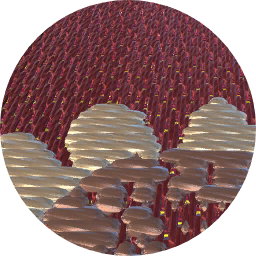Description
Loom embroidered cotton; Guatemala; 1875-1890
1931 Description: Panel of cotton loom embroidered in coloured cottons. The ground is white cotton woven with a pattern of horizontal rows of conventional birds in various sizes, in red and yellow. The panel is in two pieces joined down the centre with braid stitch in red and yellow and the birds on either side face each other. The upper hem is buttonhole stitched in red cotton; the lower hem has double running stitching in red. At two corners there is a tassel of mauve and yellow silk. A similar piece is illustrated in A P Maudslay's 'A Glimpse At Guatemala', 1899.
1975 Desription: A man's tzute from Chichicastenango. The man's headcloth is an old style one - they are now woven in red cotton. Because the men's costume from this village is so spectacular, there are many illustrations in all the books mentioned in the other catalogue entries. These show how it is worn.
The figures are not all birds - they are mostly animals. This piece has a warp-faced plainweave white cotton ground. The pattern is worked in double-faced brocading (also known as laid-in, loom embroidery etc). Several pattern yarns are used together in each pick to give the design a thick quality. The tzute is composed of two pieces woven on a backstrap loom and therefore with four selvedges. there is an embrodiered seam (randa) down the centre.
Technical Details (1995)
The red cotton is dyed with Alizarin, which was patented in Britain and Germany in 1871, and the purple floss silk with cochineal (Carlsen and Wenger, undertaken 1988, published 1991).
Warp faced plainweave.
Warp: 60 threads per inch; white cotton; Z-spun, unplied.
weft: 28 threads per inch; white coton; Z-spun, unplied.
Lower Edge: appears to have been cut; rolled under and towards the back, secured with red cotton forming a zigzag, except for some blanket stitch at the right hand end.
Upper Edge: appears to have been cut; rolled under and towards the back, secured with red cotton in blanket sttich.
Brocading: number ofdifferent types/colours of thread = 4. The brocading threads usually begin with a knot on the back of the fabric; they are loosely plied threads which often fall into separate threads making them appear unplied. Red cotton (Z3S); orange cotton (Z4S); green cotton (Z4S), purple floss silk.
Randa: the two panels are joined edge-to-edge with blocks of red and faded orange cotton giving the effect of buttonhole stitch.
Tassels: one tassel attached to the upper and one to the lower left hand corners; each is (faded) purple floss silk and each is about 6" long.
Design: the figures in both panels face the randa.
A man's headcloth, made from two pieces. Both men and women placed folded pieces of cloth on their heads as protection against the sun.
Because of its condition, this appears to be the oldest piece in the Maudslay Bequest, but the red cotton is dyed with Alizarin and so it cannot pre-date 1871. Like the headcloth displayed above (T.253-1928) this was woven in one piece, cut across the width and then joined with a decorative seam workjed withred and (faded) orange cotton.
Four different threads have been used to form the brocaded pattern, each beginning with a knot on the back of the fabric: red, orange and green cotton and a very small amount of purple floss silk (in the right hand panel, second row from the lower edge). The purple silk was dyed with cochineal; although thought of as a red dye, when used with different mordants it will produce a wide variety of colours from violet to scarlet. []
This is a man's headcloth - both men and women placed folded pieces of cloth on their heads as protection against the sun. The headcloth was woven as one long piece which was then cut across its width and the two panels were joined side-by-side with a decorative seam (known as a randa) worked with red and (faded) orange cotton. Four different threads have been used to form the brocaded pattern, each beginning with a knot on the back of the fabric: red, orange and green cotton and a very small amount of purple floss silk (in the right hand panel, second row from the lower edge). The purple silk was dyed with cochineal; although thought of as a red dye, when used with different mordants it will produce a wide variety of colours from violet to scarlet.














